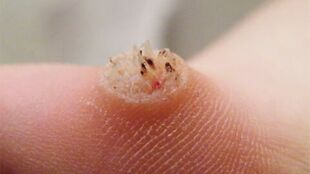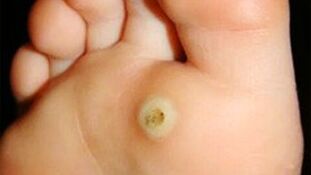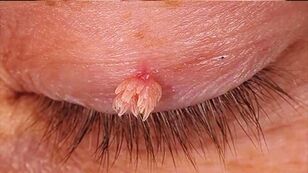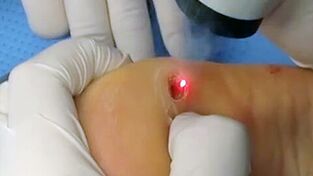
Warts are benign, unsightly neoplasms that appear on the skin when infected with the human papillomavirus. By entering the upper layers of the epidermis, the virus causes the proliferation of its cells, resulting in the appearance of warts of various shapes, sizes and colors.
The human papilloma virus infects approximately 80% of people on the planet and not all patients know its diagnosis, since HPV in most cases is asymptomatic.
Types of warts
There are different types of warts based on body location, color, size, shape, and type of pathogen.
Common or vulgar warts
The most common, their appearance does not depend on the age or gender of the patient. They are located on the hands, between the fingers, on the back of the palms (less often on the palms). Vulgar warts are irregular or round in shape and, due to their flesh-pink color, they are usually not very noticeable on the skin. The size varies from 1 to 3 mm; With prolonged infection and the absence of treatment, clusters of neoplasms may appear in the affected area.
Flat warts
Neoplasms of this species appear more frequently in children and adolescents, so its second name is juvenile warts. They are nodules of flesh or light brown color, oval or round, with a smooth surface, slightly raised above the skin. It is located mainly on the skin of the face, neck, arms, and upper body.

Plantar warts
This type of wart appears exclusively on the skin of the feet, hence its name. It is a rough growth with a layer of keratinized skin or a group of such growths. The skin around plantar warts loses its natural color and turns grayish-yellow. The surface of the wart hardens and begins to press on the healthy tissue around it, causing great discomfort.
Hanging warts
A characteristic of this species is the presence of a close joint with the surface of the skin, the so-called "legs". Hanging warts can be oblong, round, or irregular, pink or reddish in color. Such warts are located on the neck, face, armpits, and under the breast in women. Often the appearance of numerous hanging warts indicates a sharp decrease in the body's immune status.
Senile warts
Warts of this type are more likely to affect the skin of older people. They are also called seborrheic warts or keratomas. They develop due to age-related changes and deterioration of the metabolism of the cells of the epidermis, which often capture the upper part of the hair follicles. Keratomas are round in shape, with well defined boundaries, located on the scalp or on the face. The size varies from a few millimeters to 4-5 cm.

Genital warts
Genital warts or condylomata are the most unpleasant and painful type of neoplasm. Its causative agent is types 6 and 11 of the human papillomavirus. Genital warts affect the skin adjacent to the mucous membranes: on the lips and eyelids; on the genitals, urethra, anus.
Genital warts have a structure of nodular growths that are often compared to cauliflower or cockscomb. Condylomata are connected to the surface of the skin by a thin "leg. "Due to the localization in areas of the body that are susceptible to mechanical irritation, there is a high degree of injury of the genital warts and adjacent tissues, infection and development of an inflammatory process with the formation of exudative or purulent secretions.
Causes of warts
Increased activity of the human papillomavirus in the body causes warts to appear. Infection occurs through contact and everyday life: touching, shaking hands, common items, and in public places if personal hygiene is not followed. Genital warts are sexually transmitted.
The virus enters its active form if factors such as:
- severe or chronic stress;
- transferred infectious diseases;
- reduced immunity;
- hormonal alterations, inadequate metabolism;
- excessive sweating;
- skin trauma and microtrauma;
- wearing clothing and shoes made from non-natural materials.
If the disease is asymptomatic, it can only be diagnosed by laboratory means.
Warts in adults
The appearance of papillomas or warts is possible at any age. In this case, gender does not play a special role: both men and women are susceptible to HPV. At the same time, the risk of developing warts in women is higher, as their immunity is often weakened by hormone levels, pregnancy, and feeding of children. Due to the peculiarities of the anatomical structure, women are also more susceptible to the appearance of genital warts, in particular genital warts, which increase the risk of developing cervical cancer.
In men, warts appear only in case of a strong decrease in immunity, which does not happen so often with the stronger sex. At the same time, men are rarely carriers of HPV types 16 and 18, which provoke the development of oncological diseases.
Warts in children
Warts are a common occurrence in children and adolescents, as their immunity is not fully formed, as a result of which they are easily infected with papillomavirus. An important role is played by the fact that children attending kindergartens and schools, as a rule, are in conditions of increased stress, which negatively affects the body's defenses. In addition to the method of infection by domestic contact, intrauterine infection of the mother is also possible.
Most often, children develop vulgar, juvenile, or plantar warts, while juvenile warts disappear on their own between the ages of 14 and 18.

Wart treatment
When treating warts, it should be understood that it is impossible to completely eliminate the pathogen from the body - the human papillomavirus. Once in the body, it remains forever, but healthy immunity is able to keep it under control and minimize the manifestations of its vital activity.
The mere fact of the appearance of warts indicates a decrease in the immune status of the body, therefore measures to strengthen the immune system should be included in the therapy against HPV. With a reduced defense reaction of the body, even with the successful removal of warts, there is a high probability of relapse. However, in people with strong immunity, warts can go away on their own.
Therapy should be selected by a competent physician after a thorough examination. Self-medication is unacceptable, as a layman cannot distinguish a wart from a malignant neoplasm. A specialist also decides the question of removingwarts: an injured neoplasm can degenerate from benign to malignant.
There are the following ways to get rid of warts.
- Cryodestruction (freezing with liquid nitrogen). This method is especially effective for common warts. The neoplasm is exposed to liquid nitrogen for 10 to 30 seconds. This method is good for its low trauma; 1 to 5 sessions are needed to completely remove the wart.
- Laser coagulation (laser removal). The neoplasm is removed in parts under local anesthesia. At the site of the wart, a groove remains, which disappears after about a month.
- Electrocoagulation (current elimination). The wart is removed with a thin metal loop using a high frequency current. This method is characterized by the absence of bleeding and additional disinfection of tissues. The neoplasm tissues remain intact, so they can be sent for histological examination. Traces of manipulation disappear in a week.
- Surgical excision. This method is used only in extreme cases, when the neoplasms are too large or clustered in a single cluster. With local anesthesia, the wart is removed with a scalpel as in conventional surgery. The extracted material is sent for histological examination. The presence of scars at the excision site depends on the skill of the surgeon who applied the sutures.
- A chemical etching method that uses various acids or alkalis. This method is the most painful, traumatic and dangerous, since the risk of secondary tissue infection at the site of exposure is extremely high. When deciding to use it, it should be remembered that you can only act on the wart itself, without affecting the nearby skin.
Medications for the treatment of warts
Local remedies are used to treat warts, but their effectiveness depends on the age of the neoplasm: the fresher the wart is, the more likely it is to eliminate it and the patient's immunity.
Before using local remedies, you should consult with a dermatologist and conduct tests to establish the nature of the neoplasms, as exposure to medications can cause the wart cells to degenerate into malignant ones.
Non-traditional methods to treat warts
Using traditional medicine recipes:
- garlic;
- arc;
- celandine;
- spurge;
- absinthe;
- flax oil.
Traditional medicine is a good complement to conventional therapy after consulting with your doctor.
Wart Prevention
The best prevention of the appearance of warts is the usual compliance with the rules of personal hygiene: timely hand washing, use of personal manicure accessories, towels, cloths, shoes. You should not go barefoot in the shared swimming pool, showers, baths and saunas. In addition, when staying in hotels, it is advisable to take antiseptics with you for the treatment of bathrooms. In parallel, it is necessary to strengthen the immune system and take care of the general state of health.























